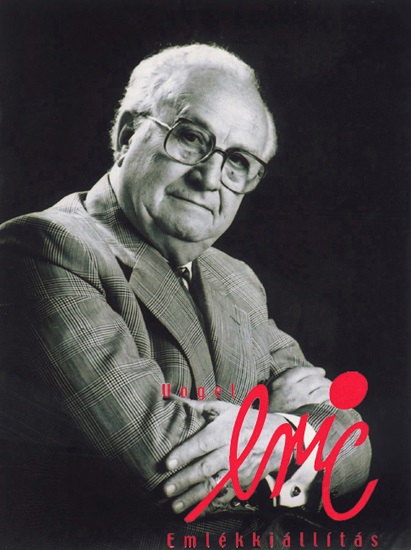Vogel Eric
1907 - 1996

Vogel Eric (source: filmkultura.hu)
Eric Vogel (1907-1996) was a Hungarian poster artist, stage and costume designer, graphic designer, newspaper illustrator and painter. His first posters are from the 1920s. He was working regularly as a poster designer from the 1930s, and continued to do so until the 1970s. His early posters and sheet music covers were bombastic Art Deco pieces, and he continued to work in this style throughout the following decades. He designed around 80 posters, but the actual number of his posters might be higher. Most of his posters advertise entertainment venues, such as theaters, bars, restaurants, cabaret venues, revues and circus shows.
He was born Imre Vogel in Budapest on June 22, 1907. His father, Izidor Vogel, was a wall painter. He had a sister and they lived with in Erzsébetváros, at Elemér utca (today Marek József) 4., in Budapest.
He studied painting with Adolf Fényes and Lipót Herman. From 1920, he was an illustrator for the newspaper Színházi Élét. Between 1925 and 1927, he studied interior design at the Academy of Applied Arts in Vienna and got to know theater and film production. From 1927, he created his first highly successful set and costume designs for the Budapest Operetta Theatre, the Capital Artists' Theater and the Hungarian Theatre.
From 1930, he was invited to the King Theater and the City Theater in Budapest as a designer for classic and new operettas, grand operettas, and musical entertainment plays. He came into contact with many entertaining and musical theater artists of the time (Gyula Hegedűs, Sári Fedák, Gyula Kabos, Hanna Honthy, Rózsi Bársony, Ida Turay, Katalin Karády, Gyula Csortos, Kamill Feleki, Pál Jávor, János Sárdy, Árpád Latabár, Kálmán Latabár, László Kazal, Ervin Kibédi, László Kabos, Manyi Kiss, Marika Németh, Róbert Rátonyi, Anikó Felföldi, János Gálvölgyi, Tivadar Horváth, Lenke Lorán, Ilona Medveczky), on whom he had an inspiring effect with his "cult of beauty" and his energetic and vibrant demeanor. He often created designs for the Royal Revue Theater, cabarets, parties - Moulin Rouge, Parisien Grill, Maxim Varieté - in a colorful, spicy style.
He married his first wife in 1933. One son was born from this marriage. He got the name Eric from the composer Imre Kálmán. His signature throughout his career was: eric.
From 1942 he was serving in labor camps, but he managed to escape and in 1944 came to Nagyvárad to work at the local theater. In Bucharest, he worked for the newspaper Scinteia and also undertook set designs for operettas. With a special permit, he traveled to Budapest in 1945, where he searched for his family, then traveled back to Nagyvárad with them, where he worked until 1947. From there, the family planned to make their way to America via Budapest with an ocean liner ticket in their pocket, but they stayed in Hungary.
From 1948, he became a member of the Budapest Operetta Theater. Later, he was the founder of the József Attila Theater, the Vidám Színpad, the Small Theater, the Chamber Variety, and the Víg Theater. He also designed the colorful letters of the logo, which defined the image of Vidám Színpad for years. He designed for many rural theaters (Békéscsaba, Debrecen, Kaposvár, Szeged, Győr, Veszprém, Szolnok) and also created costume designs for circus performances and entertainment shows.
He worked for Hungarian Television (music compilations, entertainment TV shows, Dance Congress, Hit Museum, Ligeti legends, etc.), as well as for theaters in Berlin and Paris. He also designed costumes for the Olympic silver medalist and world champion ice dancing couple Krisztina Regőczy and András Sallay. He participated in numerous foreign (Austria, Czech Republic, Italy, Paris, New York) and domestic exhibitions with his drawings and paintings. He created set and costume designs for more than 400 performances. His excellent drawing skills, thorough knowledge of the stage and the human body, and his spicy-ironic spirit radiate an unmistakably individual character.
He married his second wife in 1978. Between 1994 and 1996, he taught the skills of costume design to the girls studying women's clothing at the Madách Imre Vocational Training School in Gödöllő. He created numerous advertising and poster designs and also designed sheet music title pages for the Rózsavölgyi publishing house.
In 1996, in Szolnok, he designed the sets and costumes for the performance entitled Csárdáskirályő, but he died before the performance. At the premiere, the designer was celebrated only with a silent line-up. He was laid to rest in the Farkasrét cemetery (25/X-1-82). His grave is decorated with a caricature of János Koós. In 2007, he was elected among the honorary citizens of Erzsébetváros, in Budapest.













